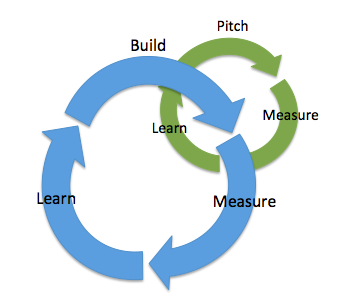Build, measure, learn.
That’s the Lean Startup mantra. It sounds simple, but it’s surprisingly tough to do well. And while it’s designed to eliminate waste and provide a speedier path through product development and validation, it can still lead to silos in how we think about startup progress. It’s so easy to spend an inordinate amount of time in the build phase, ignoring everything else, even if we know we’re really supposed to focus on “measure & learn.”
The solution is to always be pitching.
Never stop pitching your solution to prospects. Even when you’re in build mode, you can still be pitching, doing demos, showing off your solution (even in its half-baked, prototype stage). Think about two cycles through “build-measure-learn” – one is focused on the product and what you will deliver to customers; the second is focused on the pitch, and how you’ll sell to customers. Ultimately they’re both about understanding what problem you’re solving (and how painful it is) and whether or not your solution solves the problem well enough. But they’re different too. There’s a lot of learning to be done in the second cycle. The cycles aren’t completely in synch, but they definitely overlap – you’re building product while you’re pitching product and learning.

Always be pitching breaks you out of build mode faster. It keeps you in touch with customers, keeps your pitch fresh, and allows you to learn much more – on a constant basis – about what resonates with people. You can experiment with how you pitch, how you demo, what value propositions you emphasize, etc. This process isn’t about collecting feedback for development in order to tell them what to build. It’s about understanding your customers, learning about their pain, crafting the pitch and getting comfortable interfacing with the outside world. You can’t run a business in a vacuum. You have to get out there and pitch.
I’m making a point not to say “always be closing” or even “always be selling”, although this is definitely close to selling. But the goal isn’t revenue at this point, the goal is to learn what works and what doesn’t. Pitching is a more appropriate way of thinking about it.
Failed pitches are as good as successful ones. You want to be extremely selective about your beta customers; you’re not looking to open the floodgates. But practicing and refining your pitch will be extremely valuable when you put your product in customers’ hands in order to get to the measure and learn phase of the process.
 Founding Partner at
Founding Partner at 